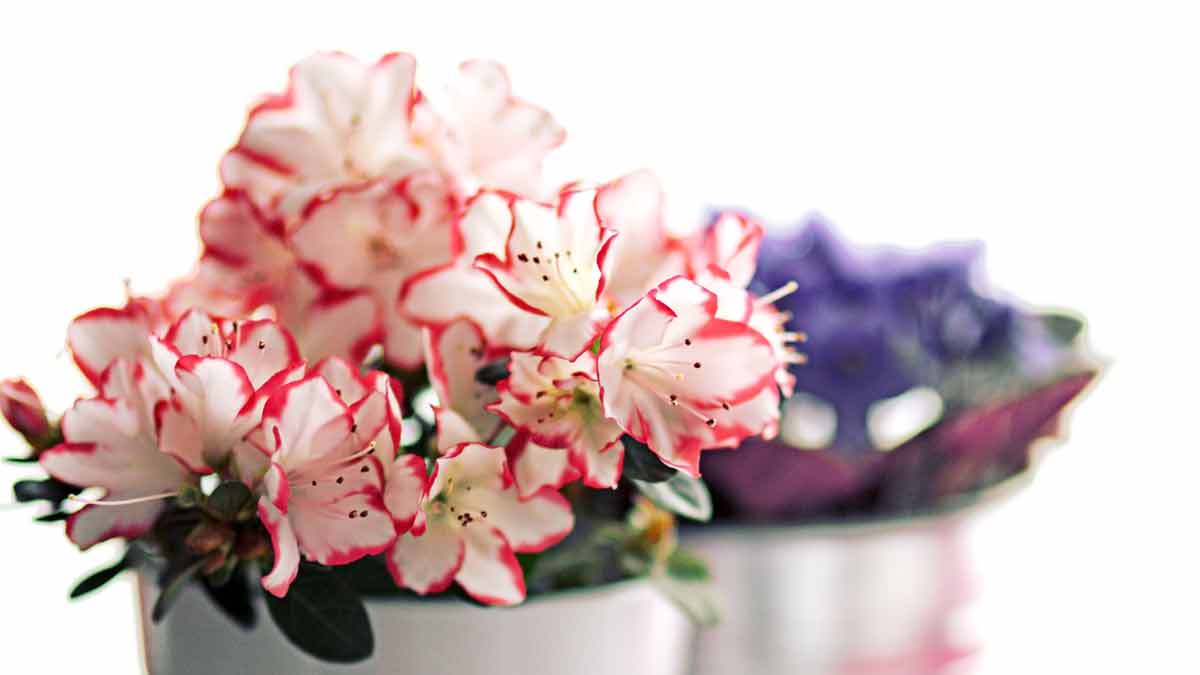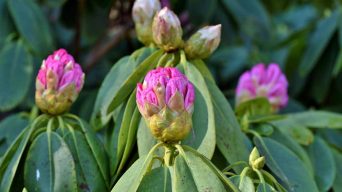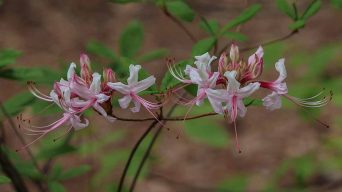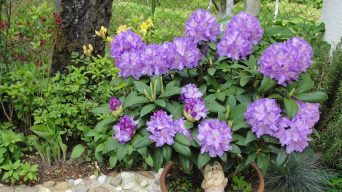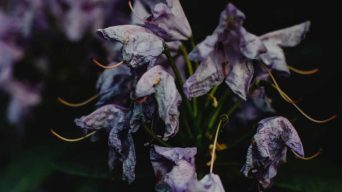Key Takeaways
- Rhododendrons can survive indoors with proper care, attention to lighting and temperature, and a suitable container and soil.
- The best rhododendron varieties for indoor growing include dwarf varieties, compact hybrids, azaleas, and other types known for their vibrant foliage and show-stopping blooms.
- Indoor rhododendrons require specific environmental conditions such as bright indirect sunlight, cool temperatures between 50°F to 60°F (10°C to 15°C), high humidity of at least 70%, and acidic soil mix rich in organic matter.
- Proper watering, fertilizing, pruning, and repotting techniques are crucial for indoor rhododendrons to ensure healthy growth.
Rhododendrons are admired for their vibrant foliage and show-stopping blooms, making them a popular choice in gardens worldwide.
But can these fascinating beauties thrive indoors? The answer lies in understanding the specific needs of this captivating plant and applying proper care techniques.
In this guide, we will explore the intricacies of growing Rhododendron indoors successfully, discussing everything from selecting the right variety to maintaining healthy growth habits.
Can Rhododendrons Survive Indoors?
Is it possible to keep Rhododendrons alive indoors?
Yes, with proper care, lighting, temperature, and suitable container and soil, Rhododendrons can survive well.
Understanding Rhododendron Growth Habits
Rhododendrons possess unique growth habits that stand out from other plant species.
One of the most notable characteristics is their shallow root system, which allows for easy container cultivation and transplanting during the fall or early growing season.
To better understand your indoor Rhododendron’s needs, it’s crucial to know their natural habitat preferences.
Rhododendrons grow in various climates but most commonly thrive in USDA zones 4-8.
They flourish under tree canopies with dappled sunlight filtering through the branches, protecting them from intense heat and direct sun exposure.
By mimicking these native habitat conditions within your home or indoor space, you’ll create an ideal environment for successful rhododendron cultivation indoors.
Choosing The Right Container And Soil
Selecting the appropriate container and soil is crucial for the successful growth of rhododendrons indoors.
Begin by choosing a container with ample drainage holes to prevent root rot and water stagnation, two common issues potted rhododendrons face.
Rhododendrons are acid-loving plants, so using a soil mix high in organic matter is essential.
A mixture of peat moss, pine bark mulch, or pine needles can help create an acidic environment conducive to healthy root development, ensuring your indoor Rhododendron thrives.
Light And Temperature Considerations
Proper light and temperature are critical factors in successfully growing rhododendrons indoors.
These beautiful plants require a delicate balance of bright, indirect sunlight and cool temperatures to thrive.
Regarding temperature, Rhododendrons flourish in cooler environments that mimic their natural habitat in mountainous regions.
Maintaining an ideal temperature range between 50°F to 60°F (10°C to 15°C) during the daytime is crucial, while nighttime conditions should hover around 45°F to 55°F (7°C to 13°C).
Keep these fascinating beauties away from heating vents or other sources of warm air, which may lead to wilting or foliage damage.
Humidity Requirements
Rhododendrons require high levels of humidity to thrive indoors.
They need at least 70% humidity to stay healthy and produce their iconic blooms.
Unfortunately, the dry air found in most homes can make it challenging for your indoor Rhododendron to get the moisture it needs.
Low humidity levels can cause wilting leaves, stunted growth, leading to plant death.
To help your plant adapt, you may need to invest in a humidifier or use pebble trays filled with water beneath the pot.
Additionally, misting the leaves regularly can also improve ambient moisture levels around your rhododendron plant.
Caring For Indoor Rhododendrons
If you plan to grow rhododendrons indoors, knowing the proper watering and fertilizing methods, pruning and repotting techniques, pest control, and air circulation is important.
Our expert tips will guide you toward successful indoor rhododendron growth. Keep reading to learn more.
Watering And Fertilizing Needs
Proper watering and fertilizing are essential for the health and vitality of indoor rhododendrons.
Here are some tips on how to keep your plant thriving:
- Water deeply, but not too often. Rhododendrons like consistently moist soil, so water until it drains out of the bottom of the pot. However, be careful not to overwater, as this can lead to root rot.
- Check the soil frequently. Stick your finger into the soil up to your knuckle – if it feels dry at that depth, it’s time to water.
- Use a high-quality fertilizer explicitly formulated for acid-loving plants like rhododendrons. Apply in fall or early spring when new growth begins.
- Fertilize sparingly – too much can burn the roots and damage the plant. Follow package instructions carefully and err on the side of caution.
- Avoid using fertilizers with high levels of phosphorous or potassium, as these can interfere with a rhododendron’s ability to absorb important nutrients like iron.
- If you notice yellowing leaves or stunted growth, your plant may be experiencing nutrient deficiencies – adjust fertilization accordingly.
Pruning And Repotting Techniques
To keep your indoor Rhododendron healthy, it is crucial to prune and repot the plant regularly.
Here are some tips to help you get started:
- Prune your Rhododendron right after it blooms in the spring to promote new growth and maximize its spring display.
- Use clean, sharp pruning shears to remove dead or diseased wood and branches that cross over each other.
- Cut back the tips of young shoots to encourage a more compact growth habit.
- When repotting your Rhododendron, choose a container slightly larger than its current one, as too much space can cause the soil to stay too moist, leading to root rot.
- Use an acidic potting mix that contains peat moss and perlite for good drainage and enhanced soil acidity.
- 6. Water the newly potted plant thoroughly but avoid overwatering it in the weeks following repotting.
Managing Pests And Diseases
Proper pest and disease management is essential when growing rhododendrons indoors.
Here are some tips on how to manage pests and diseases that may affect your indoor rhododendrons:
- Regularly inspect your plants for signs of insect pests, such as aphids, spider mites, and scale insects. These can be treated with insecticidal soap or neem oil.
- Watch out for leaf spots caused by fungal diseases such as Glomerella cingulata and powdery mildew. These can be controlled with fungicides or by removing infected leaves and improving air circulation.
- Rhododendrons may also suffer from root rot caused by overly wet soil. To prevent this, ensure the soil has adequate drainage and avoid overwatering.
- Deer can also pose a threat to outdoor rhododendrons. Using deer repellents or fences may help to keep them at bay.
- Maintaining good hygiene when caring for rhododendrons is important to reduce the risk of disease spread. This includes regularly cleaning pruning tools and avoiding watering leaves in humid conditions.
By taking these steps, you can help ensure that your indoor rhododendrons remain healthy and free from pests and diseases throughout the year.
Providing Adequate Air Circulation
Proper air circulation is crucial for indoor Rhododendrons to thrive.
These plants are susceptible to fungal diseases, and good air movement helps prevent such problems.
A fan can be a helpful tool in achieving proper air circulation.
In addition to improving ventilation, placing your Rhododendron in an area with good air circulation helps keep pests away.
Insects such as spider mites and mealybugs thrive in damp environments with poor airflow.
Best Rhododendron Varieties For Indoor Growing
If you’re thinking of growing rhododendrons indoors, here are some of the best varieties to consider: dwarf types, compact hybrids, azaleas, and other varieties that are known for their bright foliage and beautiful blooms.
Dwarf Varieties
If you want to grow rhododendrons indoors, dwarf varieties are the perfect choice for small spaces.
These compact plants offer a variety of vibrant foliage and show-stopping blooms that will add beauty to your indoor garden.
Here are some popular dwarf varieties to consider:
- Blue Tit: This variety produces clusters of bell-shaped flowers in bright pink, with evergreen foliage that turns bronze in the winter.
- Dreamland: With trumpet-shaped flowers in soft pink and green leaves, this variety is perfect for those who prefer a subtle touch of color.
- Fragrantissimum: If you want your indoor space to smell heavenly, this variety has fragrant white flowers that bloom in late winter or early spring.
- Ginny Gee: This low-growing shrub offers beautiful lavender-pink flowers and dense foliage that turns bronze in the winter.
- Ken Janeck: This heat-tolerant plant produces unique ivory-white flowers with specks of red and attractive narrow foliage.
Dwarf rhododendrons are easy to care for and thrive indoors with proper attention to light, temperature, humidity, watering, fertilizing, pruning, and repotting techniques.
By choosing the right container and soil mix that mimics their natural habitat, these fascinating beauties will flourish in your indoor garden all year round.
Compact Hybrids
Compact hybrids are a great option if you’re looking for a rhododendron variety suitable for indoor growing.
These varieties are specifically bred to adapt to container planting and indoor environments.
Here are a few unique compact hybrids to consider:
- ‘PJM Elite‘: This variety has showy lavender-pink flowers and attractive evergreen foliage. It’s also more heat tolerant than some other rhododendron species.
- ‘Dora Amateis‘: With delicate pink blossoms and glossy green leaves, this variety is easy to care for and blooms in the early spring.
- ‘Wheeler’s Dwarf‘: This small, slow-growing shrub features deep red flower buds that open into pink blooms. It’s an excellent choice for smaller containers or terrariums.
- ‘Mary Fleming‘: This dwarf hybrid has vibrant pink flowers, ruffled petals, and glossy green leaves. It’s well-suited to growing indoors because of its compact size and adaptability.
- ‘Ginny Gee‘: An actual miniature, Ginny Gee grows just 2-3 feet tall with small leaves and clusters of bright pink blossoms in the spring.
In general, compact hybrids tend to have smaller leaves, shorter internodes (the spaces between leaves on a stem), and slower growth rates than other types of rhododendrons.
This makes them more manageable for indoor growing, where space is often limited.
Remember that while these varieties are better suited to indoor growing than others, they still require specific care and attention to thrive indoors – so consult a comprehensive guide before diving in!
Azaleas
Azaleas are a widespread variety of rhododendrons that can be grown indoors successfully.
- They are known for their stunning, trumpet-shaped flowers that bloom in clusters.
- Azaleas come in many varieties and colors, including shades of pink, red, and white.
- They prefer acidic soil with a pH between 4.5 and 6.0, similar to other acid-loving plants like rhododendrons.
- Azaleas require regular watering to keep the soil moist but not waterlogged, especially during their growing season in late spring and early summer.
- Fertilizing with an acidic fertilizer every two weeks can also help azaleas thrive indoors.
- To encourage bushy growth, pruning should be done after flowering has finished.
- Yellow leaves on azaleas may indicate an iron deficiency or alkaline soil conditions and can be remedied by adding an acidic fertilizer or changing the soil.
- There are both evergreen and deciduous varieties of azaleas available for indoor growing.
- Some popular types include the Catawba Rhododendron, Indoor Azalea (Rhododendron simsii), and Nova Zembla Rhododendron.
- As part of the rhododendron genus, azaleas have long been mainstays in gardens due to their large and colorful flowers.
Other Varieties To Consider
If you’re looking for more options beyond dwarf varieties, compact hybrids, and azaleas, here are some other rhododendron varieties to consider:
- Rhododendron simsii: Also known as the Indian Azalea, this small evergreen shrub produces masses of flowers in shades of pink, red, or white. It prefers bright but indirect light and moist, well-drained soil.
- Catawba Rhododendron: This large evergreen shrub is native to North America and features clusters of stunning purple-pink flowers in late spring. It grows best in acidic soil with good drainage and partial shade.
- Rhododendron ponticum: A versatile species that can grow into a large shrub or even a small tree, depending on its training and pruning. It produces bell-shaped flowers in shades of pink or purple and prefers slightly acidic soil and dappled shade.
- Deciduous Azaleas: These azaleas shed their leaves in winter but produce some of the most vibrant blooms in spring or summer. They come in various colors, from bright orange to deep red or yellow, and prefer well-drained soil with plenty of organic matter.
- Nova Zembla Rhododendron: One of the hardiest rhododendrons available, this evergreen shrub can withstand temperatures as low as -25°F (-32°C). Its vibrant red flowers make a striking contrast against its dark green foliage.
By considering these other varieties of rhododendrons besides the traditional choices for indoor growing, you can select one that suits your aesthetic preferences while still growing successfully indoors with proper care and attention.
Common Challenges Of Indoor Rhododendron Growing
Growing rhododendrons indoors can be challenging due to leaf drop, wilting, root rot, and nutrient deficiencies.
Leaf Drop
Leaf drop is a common concern for indoor rhododendron growers.
This issue has several possible causes, including dry air, over-watering, chemical damage, and disease.
The problem can be resolved by adjusting the plant’s watering regimen or increasing humidity levels around it.
Monitor soil moisture regularly and avoid over-fertilizing, as excess salt buildup can lead to leaf drop.
It’s important to remember that some leaf loss is expected during the winter months as rhododendrons enter dormancy.
Wilting
Wilting is a common problem that can affect indoor rhododendrons.
The leaves become limp and droop due to lack of water, excess heat, or pests/disease infestations.
To prevent wilting, it is essential to maintain consistent soil moisture by watering the plant regularly without overwatering.
Ensuring adequate air circulation and avoiding exposing the plant to extreme temperatures is also crucial.
If wilting does occur, investigate further for potential underlying issues such as root rot or pest problems using symptoms like rolling leaves and reddish-brown discoloration at the base of the plant.
Root Rot
Root rot is one of the most common problems with indoor rhododendrons and azaleas.
This fungal disease affects the roots, causing them to decay and ultimately leading to plant death.
Root rot symptoms include yellowed leaves that curl downward, wilting and stunted growth.
To prevent root rot in container-grown rhododendrons, ensure adequate drainage by using a well-draining soil mix and pot with bottom drainage holes.
Avoid overwatering as it can lead to waterlogged soil, quickly becoming a breeding ground for fungi that cause root rot.
Nutrient Deficiencies
Indoor rhododendrons may experience nutrient deficiencies, which can cause a range of issues like yellowing leaves or stunted growth.
This is often due to the limitations of container gardening and the lack of access to soil microorganisms that help break down nutrients for plant use.
To prevent this, it’s essential to regularly fertilize your indoor Rhododendron with high-quality fertilizer designed for acid-loving plants.
Organic options like fish emulsion or blood meal are excellent nitrogen sources, while bone meal can provide much-needed phosphorus.
Tips For Success
Here are some helpful tips to ensure the success of your indoor Rhododendron:
- Select a well-lit location.
- Regularly monitor and adjust temperature and humidity levels.
- Provide high-quality fertilizers.
- Use proper pruning techniques to manage pests and diseases.
By following these guidelines, you can promote optimal growth and health for your plant.
Choosing The Right Location
To ensure that your indoor Rhododendron thrives, choosing the right location for its growth is crucial.
Rhododendrons prefer areas with dappled shade or partial sunlight, so look for a spot in your home that gets at least 4-6 hours of indirect light each day.
Apart from lighting, pay attention to temperature and humidity levels. Most rhododendrons grow best in temperatures between 60-70°F during the day and cooler temperatures at night.
Additionally, these plants require high humidity to survive indoors successfully.
Keeping an eye on these factors is important in ensuring your indoor Rhododendron stays healthy and produces stunning blooms year-round.
Regularly Monitoring And Adjusting Temperature And Humidity
It’s important to monitor temperature and humidity levels when growing rhododendrons indoors closely.
Here are some tips for monitoring and adjusting these conditions:
- Use a thermometer to check the temperature in the growing area regularly. Aim for a consistent temperature between 60-65°F during the day and 50-55°F at night.
- Use a hygrometer to measure humidity levels in the growing area regularly. Rhododendrons like high humidity levels between 40-60%, so consider using a humidifier if your home is particularly dry.
- Adjust humidity levels by misting the leaves of your Rhododendron with water or placing a tray filled with water near the plant.
- Consider using grow lights or moving your plant to an area with more sunlight if your Rhododendron isn’t blooming or appears stunted. Rhododendrons need at least six hours of indirect sunlight per day.
- Monitor temperature and humidity levels closely during seasons with extreme weather conditions, such as winter or summer, and make adjustments as needed to ensure optimal growing conditions for your indoor Rhododendron.
Regularly monitoring and adjusting temperature and humidity levels can help create a more hospitable environment for your indoor rhododendrons, leading to healthier plants and beautiful blooms.
Providing Adequate Light
Proper lighting is crucial for indoor rhododendron growth, as it’s the most important factor affecting plant growth in interiors.
Rhododendrons require bright but indirect light to grow and thrive.
All rhododendrons and azaleas will flourish well in light shade.
Giving tropical plants an east-facing window with early morning sun and bright indirect light for the rest of the day is ideal for indoor growth.
Alternatively, you can use fluorescent lights or LED grow lights to supplement natural light if a room doesn’t have enough brightness.
Keep a close eye on your plants’ foliage color – dark green means there is not enough direct sunlight, while yellowish tint means excessive direct sunlight or lack of moisture/soil acidity imbalance.
Using High-Quality Fertilizers
When fertilizing your indoor Rhododendron, using high-quality products is vital.
A balanced fertilizer containing nitrogen, phosphorus, and potassium can be used monthly during the growing season.
Blood meal without fillers or a product containing zinc can also be used as a source of nitrogen.
One important tip is only to use fertilizers when necessary – if your plant isn’t showing signs of malnutrition, then there’s no need to add extra nutrients.
Additionally, selecting plants that are well-suited for the soil type in your area can help reduce the need for additional fertilization.
Final Thoughts
Growing rhododendrons indoors is possible with the proper care and attention.
Understanding the growth habits of these plants, providing ample light, humidity, and temperature control, and choosing the correct container and soil are all important considerations for success.
Regular pruning, watering, fertilizing, and pest management will also help ensure healthy growth.
Plant owners can enjoy year-round blooming specimens that will add vibrant color and beauty to any space by selecting suitable varieties that can thrive in indoor environments.

